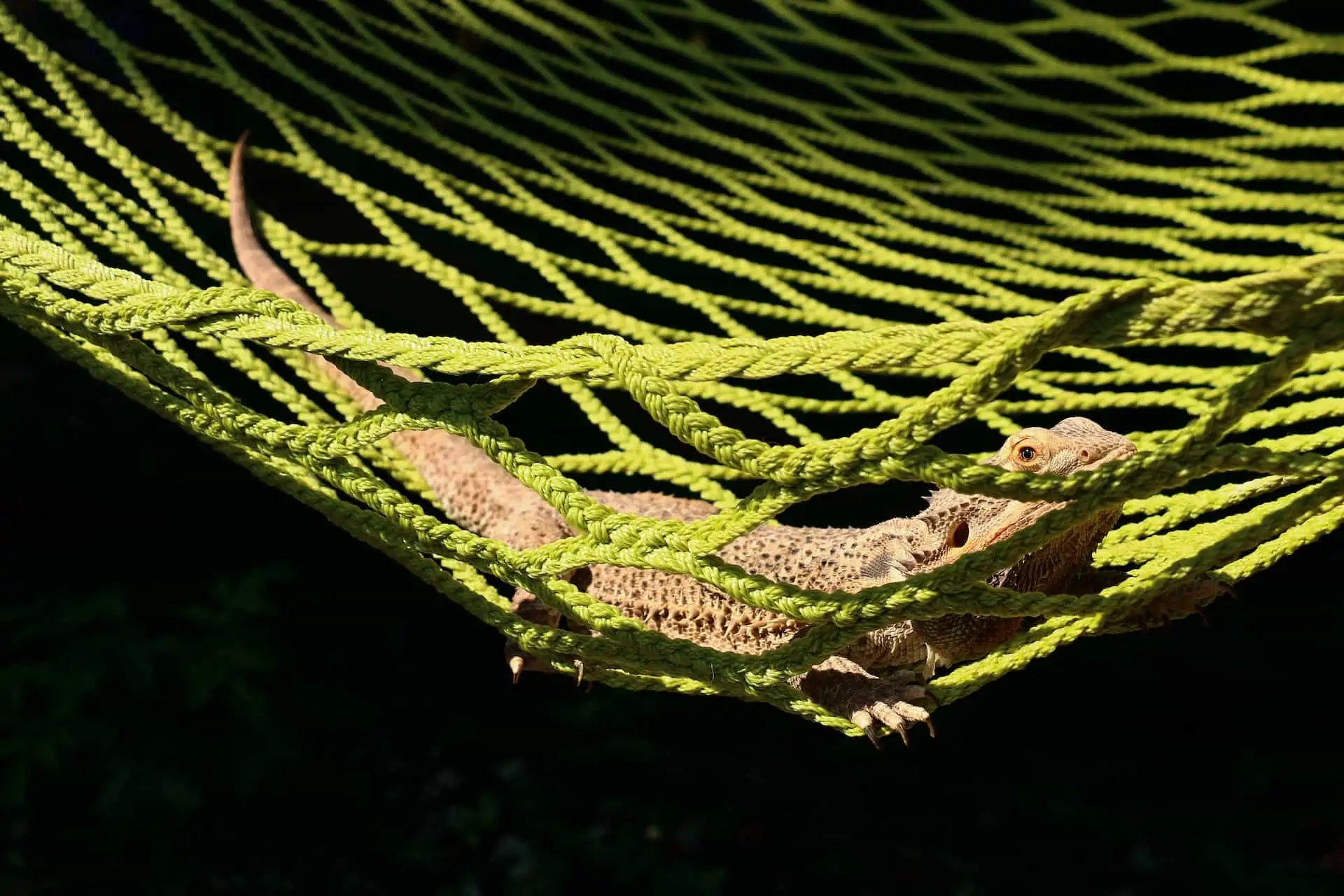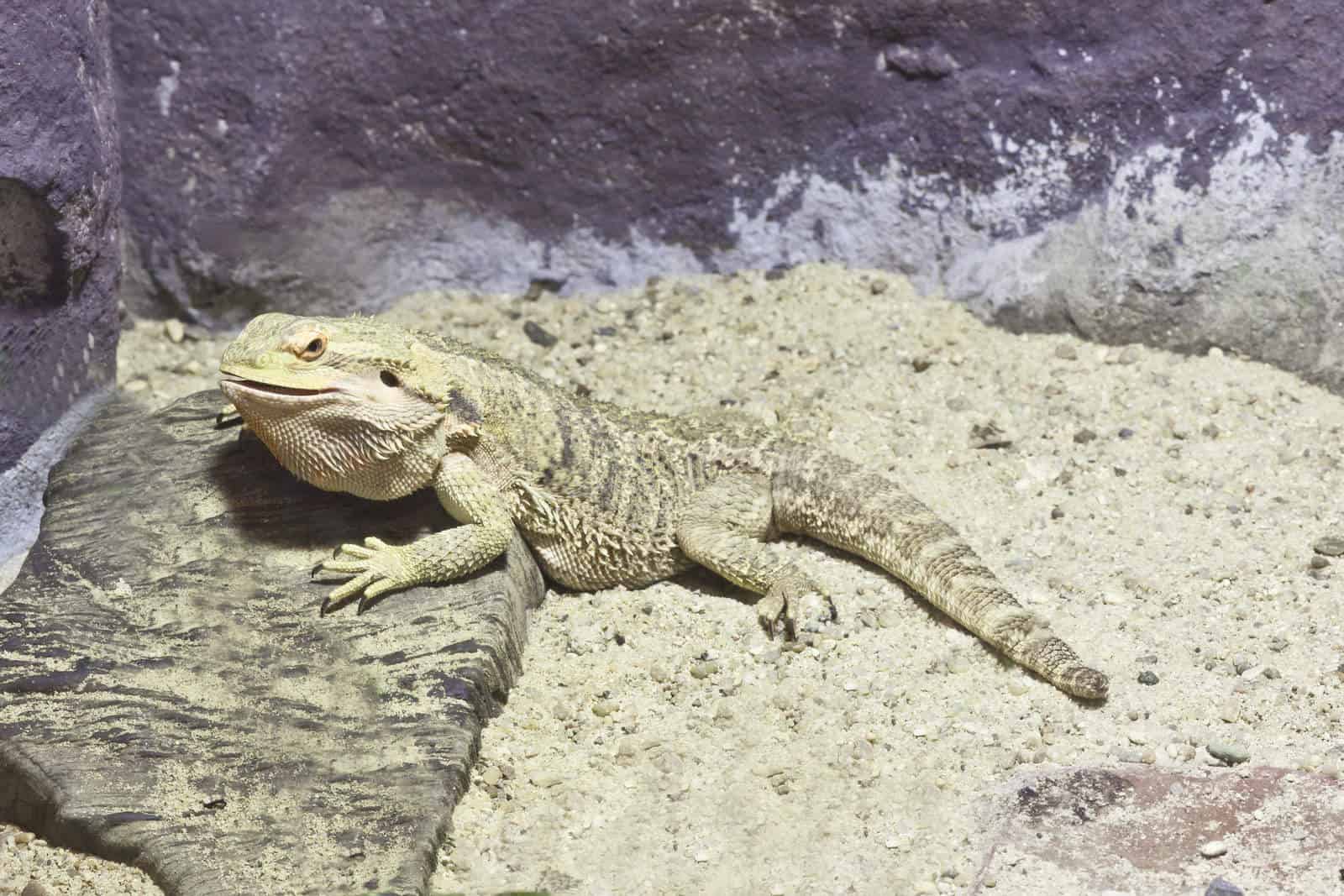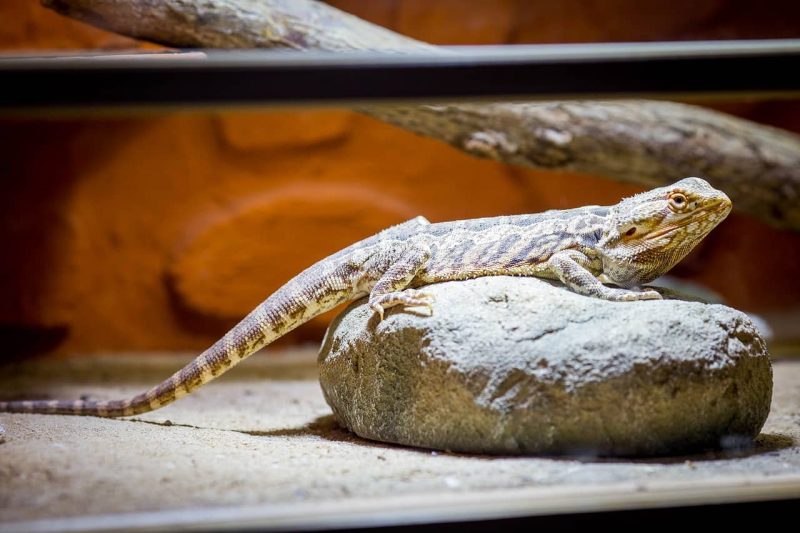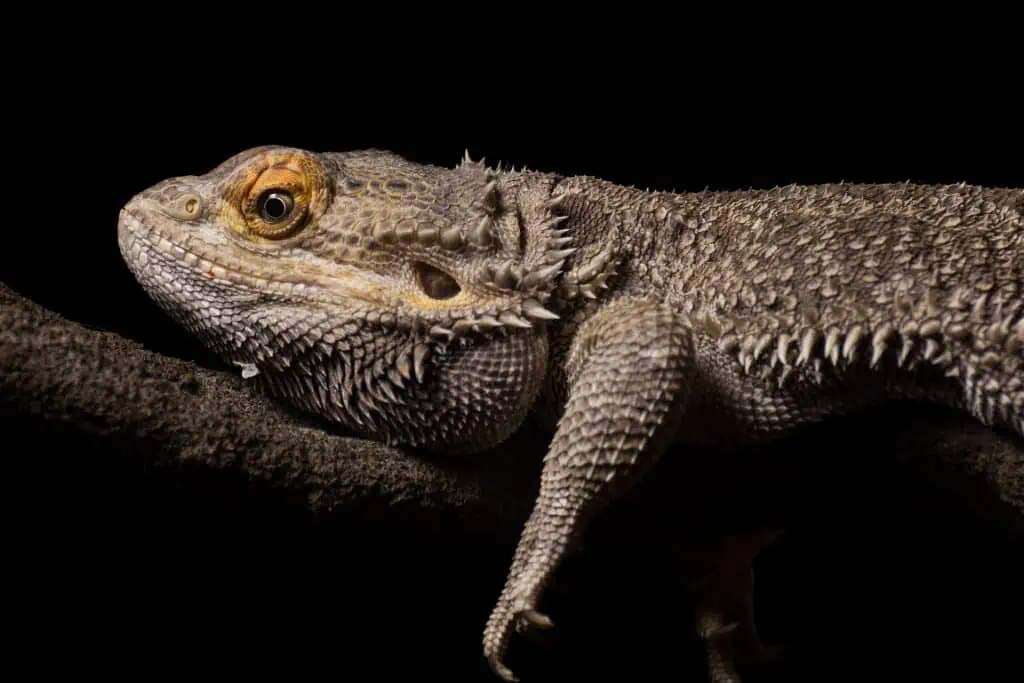Does your bearded dragon spend a lot of time sleeping? Does your bearded dragon seem lazy or lethargic? Bearded dragons are normally alert and active. If you answered “yes” to any of these questions, it is important that you investigate the situation further.
Under normal conditions, there are situations when bearded dragons sleep a lot or do not move around. However, these behaviors can also be the result of inadequate care. Unfortunately, more often than not, a beardie that is not active is declining in health as it is not getting the proper heating, lighting, or diet, or it is inflicted with a disease.
How Much Should My Bearded Dragon Be Sleeping?
Bearded dragons are diurnal lizards, meaning they are active daily and sleep at night. Just as with people, each bearded dragon has its own personality. Some beardies are very active, while others may be less active and sleep during parts of the day.
Instead of asking how much bearded dragons should be sleeping, a better question is, “What else is going on?” If your bearded dragon seems lazy and sleeps a lot, consider its overall appearance and behavior. Check for the following:
- Is your bearded dragon lethargic, not eating, with eyes closed?
- Does your lizard look healthy?
- Does your pet have a good appetite?
- Does your beardie appear alert?
- Is your beardie responding to stimuli?
- Does your bearded dragon stay in one spot?
- Does your dragon spend time basking?
If you can answer “yes” to all of these questions, then it is a good chance that your beardie is okay. Not being active may be just part of its personality. However, I recommend that you continue to read this article to confirm that this is the case.
Should My Bearded Dragon Sleep All Day?
Is your bearded dragon sleeping during the day? As stated earlier, bearded dragons are active daily; however, some individuals may spend some time sleeping. If your dragon sleeps all day, that may be a warning that something is wrong with it or is in brumation, which will be discussed later in this article.
Reasons Why Your Bearded Dragon Is Sleeping So Much
Laziness in a bearded dragon is either a:
- Personality trait
- A sign that it is not getting the proper care.
- A sign that it’s in brumation.
If your bearded dragon appears healthy otherwise, it may be just its personality. Keep reading for more information so that you can make a better determination.
Bad Lighting Setup
In their natural habitat, bearded dragons live in the desert, where there is strong exposure to UVB light. This same kind of lighting needs to be replicated in captivity. Without the proper lighting, bearded dragons will stop eating, become lethargic, and develop metabolic bone disease.
Make sure that your pet is getting UVB lightning. There are different kinds of UVB lighting, so getting the best kind for bearded dragons is important. A good source of UVB lighting is the high-intensity kind. Examples of this kind of bulb include the Arcadia T5 lighting range or Exo Terra Solar Glow.
Additionally, UVB lighting loses its UVB output after around six months. For this reason, it is important to replace the bulbs after this period of time.
The Tank Is Cold
Bearded dragons are from the deserts of Australia, where it gets very got. Without the proper heat, you will end up with a lethargic bearded dragon.
Provide your pet’s enclosure with a thermal gradient, meaning that the temperature varies in different parts of the enclosure. The warmest part of the enclosure should be where your pet basks.
It should be kept between 9-110 degrees Fahrenheit. The cooler parts of the enclosure should be between 75-85 degrees Fahrenheit. To keep your bearded dragon at the right temperature, I suggest you use one of the following methods:
- Basking Spot Lamps: These incandescent bulbs are specially made for reptiles, and they produce both light and heat.
- Nighttime Heating Lamps: These bulbs can provide heat during the nighttime without interrupting the lizard’s sleep cycle. The nighttime temperature should not go below 70 degrees Fahrenheit.
- Mercury Vapor Bulbs: These bulbs provide both heat and ultraviolet lighting.
- Ceramic Heat Emitters: This product will produce radiant heat. However, I recommend that this not be your main heat source. Use as a supplementary heat source.
- Under Tank Heating Pads: These pads are placed underneath the enclosure; they heat the enclosure by warming the substrate. Heating pads come in different sizes, depending on the enclosure size.
- What Not to Use: Do not use heat rocks or heat caves; these products can cause burning in reptiles.
- A Note About Bulb Wattage: The larger the enclosure, the more wattage you need. For this reason, it may take some experimentation on your part to determine what wattage you need to achieve the proper temperature.
Your Bearded Dragon Is Ill
Another cause of sleepiness or lethargy is an illness. The following are some of the more common ailments that bearded dragons get:
Infectious Stomatitis
Commonly known as mouth rot, infectious stomatitis presents as white or yellow-gray patches that occur within the mouth. Also, there may be swelling in the mouth and drooling.
Lizards with mouth rot will stop eating and be lethargic. If you suspect mouth rot, I recommend that you bring your lizard to the veterinarian.
Metabolic Bone Disease (MBD)
As mentioned previously, Metabolic Bone Disease (MBD) is caused by inadequate UVB lighting. Without the proper UVB lighting, bearded dragons cannot develop healthy bones. When UVB lighting is lacking, the lizard’s body develops a shortage of calcium. The body then draws calcium from the bones.
Symptoms that may indicate MBD include:
- An unhealthy and weak appearance.
- Muscle tremors
- The distorted appearance of the legs and spine.
- Twitching
- The mouth remains open.
- Difficulty controlling the hind legs.
Dehydration
While bearded dragons are desert dwellers, they must always have water available to them. If they are not getting enough water, they will become dehydrated. Signs that your bearded dragon is dehydrated include lethargy, loss of skin elasticity, and sunken eyes.
To test your lizard’s skin elasticity, gently pinch your lizard’s skin. If the skin does immediately snap back upon releasing it, that is a sign that your dragon is dehydrated.
If you believe that your beardie is dehydrated, offer it water. If it does not drink, you can also use an eye dropper to place water on its snout. Your pet may lick it up. In addition to water, you can also offer Pedialyte or Gatorade. These fluids help your pet restore its electrolytes.
Respiratory Problems
Another potential cause of excessive sleeping or laziness is respiratory problems. Signs to look out for include:
- Lethargy
- Breathing with their mouth open or gasping for air.
- Discharge from the nostrils or eyes.
- Loss of appetite
- Problems with shedding its skin.
If you suspect that your bearded dragon has a respiratory illness, get your pet to a veterinarian as soon as possible. Respiratory disease is caused by improper husbandry.
Check the humidity level of the enclosure. It should be between 30 and 40 percent. Anything above that is too high.
Also, check the temperature; it should be between 92-110 degrees Fahrenheit, and the coolest part is between 75-85 degrees Fahrenheit.
Impaction
Bearded dragons that are not fed properly can develop blockages in their digestive tract, known as impactions. Impactions are caused by ingesting foreign substances, such as substrates or certain foods. Mealworms and large crickets have a tough outer coating known as chitin.
If you feed your beardie these food items too frequently, it may cause an impaction on your pet.
Signs that may indicate impaction include:
- Difficulty in movement.
- Difficulty in using their hind legs.
- Dragging of the legs.
- Trembling of the legs.
- No defecation or pooping.
If you think your lizard has an impaction, have a veterinarian see your pet as soon as possible.
Your Bearded Dragon Has a Bad Diet
Another potential cause for your beardie being sleepy or lazy is it is not getting the proper nutrition. Being omnivores, bearded dragons need to have both plant and animal matter in their diet. Baby beardies need more protein than plant matter, while adults need more plant matter than protein.
Recommended sources of protein include:
- Dubia roaches
- Butter worms
- Earthworms
- Silkworms
- Phoenix worms
- Wax worms
- Mealworms: Feed only to adult dragons and do so sparingly.
Recommended sources of plant matter include:
- Acorn squash
- Asparagus
- Alfalfa
- Bok choy
- Butternut squash
- Bell peppers
- Cucumber
- Carrots
- Celery
- Cilantro
- Collard greens
- Dandelion leaves
- Endive
- Green cabbage
- Hibiscus
- Kale
- Mustard greens
- Turnip greens
- Watercress
- Red cabbage
Calcium Deficiency in Bearded Dragons
Your bearded dragon’s lethargy may be due to it not receiving enough calcium, which is common when these lizards are not kept in the proper conditions. Causes for calcium deficiency include:
- Feed your pet a calcium-deficient diet.
- Feed your lizard a diet that has excess phosphorus or oxalates.
- Not providing a calcium supplement.
- Inadequate lighting.
The following are ways to make sure that your bearded dragon is getting enough calcium:
Provide a Healthy and Varied Diet
Choose fruits and vegetables that are rich in calcium but low in oxalates and phosphorus. Examples of such foods include:
Vegetables
- Turnip Greens
- Kale
- Mustard Greens
- Beet Greens
- Pak-Choi (Bok Choy)
- Okra
- Swiss Chard
- Broccoli Raab (Rapini)
- Podded Peas
- Acorn Squash
- Butternut Squash
- Parsley
- Sweet Potatoes
- Cabbage
- Celeriac
- Broccoli
- Brussels Sprouts
- Soybean Sprouts
- Green (Snap) Beans
- Collard greens
- Dandelion leaves
- Endive or escarole
- Turnip greens
- Rosemary
- Zucchini
- Grape leaves
Fruits
- Bananas
- Blackberries
- Blueberries
- Cherries
- Strawberries
- Apples
- Apricots
- Lemons
- Peaches
Calcium Supplements
Provide your bearded dragon with a calcium supplement. Choose a calcium supplement that is free of phosphorus. You can give your pet calcium by dusting its food or gut-loading it.
When dusting, sprinkle the calcium supplement on your pet’s food, be it prey items, vegetables, or fruits. With gut loading, you want to feed the insect prey nutritious foods covered with a calcium supplement. Feed the insects to your pet 24 hours later.
It is important to note that calcium supplements are not a replacement for UVB lighting. UVB lighting provides reptiles with vitamin D3, and vitamin D3 is needed to absorb calcium.
Starting Brumation
Does your bearded dragon spend a lot of time not moving? Bearded dragons, along with some other reptiles, may undergo brumation. Brumation is like hibernation, except it does not entail the lizard entering a completely dormant state. During brumation, beardies may occasionally move around and eat.
Just as with hibernation, brumation is used by beardies to conserve energy when the weather cools. They may brumate for three to four months. Even if you keep the enclosure at the recommended temperature, your beardie may still undergo brumation due to changes in the weather.
When preparing to brumate, bearded lizards will find the most secluded part of the enclosure. They will not brumate in open spaces. This is one way to tell if your pet is bromating or if its sleepiness is the result of something else. Also, bearded dragons do not brumate until the age of nine months or older.
If your bearded dragon is bromating, do the following:
- Bring down the enclosure temperature to around 72-75 degrees Fahrenheit.
- Keep the enclosure lighting on for eight hours daily.
- Continue to offer water and food.
You can also distinguish between brumation and illness by weight. If your bearded dragon has lost more than 51 grams over three months, it is not bromating and needs to be seen by a veterinarian.
Shedding
When approaching the time to shed, bearded dragons will become more lethargic. To avoid predators, it is normal to form them to find a place to hide until they have completed the shedding process.
You can tell if your bearded dragon is shedding if their skin becomes paler and starts to peel. You can help your pet shed by letting it soak in warm water for about 15 minutes. The water should be no higher than the height of your lizard’s shoulders. Also, you should keep an eye on it at all times.
Getting Old
When properly cared for, bearded dragons can live up to ten years in captivity. As one may expect, older beardies will be less active and sleep more.
Feeling Stressed
Another factor that can result in a lethargic bearded dragon is stress. Most sources of stress are husbandry related, meaning they are not getting the proper temperature, humidity, or diet they need.
Other sources of stress include over-handling, disturbances from outside the enclosure, or tank mates. Bearded dragons are solitary animals, so housing two or more together can lead to stress.
Revaluating your husbandry practices, and making the needed changes, is the way to deal with stress.
Feeling Anxious About Moving
This topic is closely related to the previous one, stress. Moving your beardie from one enclosure to another can also result in stress. Similarly, making a major change to their enclosure can do the same.
It is natural for bearded dragons to become wary of anything new. It can take time for them to realize that the changes in their environment are not threatening.
Also, this kind of reaction to novel situations occurs when you first bring your beardie home. It can take your bearded dragon a few weeks to get used to its new home.
Lacking Stimulation
Bearded dragons that spend much of their time huddled in a corner may be doing so because they do not feel safe. For these reasons, it is important to set up their enclosure properly. A good setup enclosure will make your pet feel safe and provide it with stimulation.
In their natural habitat, bearded dragons use holes, crevices, and other places to hide when they feel threatened. For this reason, it is important that you provide a place for it to hide. You can purchase hides at a reptile store or make your own using a piece of PVC pipe.
Besides providing your beardie with a sense of safety, hides can be used by beardies when shedding, or they desire a cooler temperature. Also, the darkness provided by hide can make them feel calmer.
Bearded dragons are semi-arboreal, meaning that they sometimes like to climb. Provide branches for your pet to climb on. When selecting branches for the enclosure, ensure that they are clean and that they are free of parasites.
You can avoid this potential problem by purchasing branches from a reptile dealer. If you plan to gather your own branches, never use cedar, cypress, pine, or yew, as they are toxic. Other ways to increase stimulation are to:
- Offer your pet a varied diet.
- Let it roam around outside of its cage.
- Offer it toys.
What Should I Do if My Bearded Dragon Keeps
Sleeping a Lot?
In this article, we covered a range of possibilities for why your bearded dragon seems to be always sleeping. Except for brumation, shedding, and old age, all these possibilities result from inadequate care.
Use this article to determine if you are meeting your pet’s care needs. If their care is falling short, make the needed adjustments.
While making corrections to their care is important, that may not be enough. In the section on illnesses, we covered a variety of diseases. The following are some of the symptoms of these diseases. If your bearded dragon exhibits any of these symptoms, I encourage you to have your pet seen by a veterinarian.
Disease Symptoms:
- Loss of weight
- Constipation
- Problems walking
- Vomiting
- Diarrhea
- Sunken eyes
- Twitching of the body or limbs
- Swelling in the mouth or other areas
- The distorted appearance of the legs or spine.
Responsibility Is Owed
We hope you enjoyed this article. As reptile owners, we are responsible for ensuring that our scaly friends get the best care possible. If your bearded dragon is sleeping a lot, it is important that you identify the reason and take the needed action. We would enjoy reading your comments, and please share this article.






